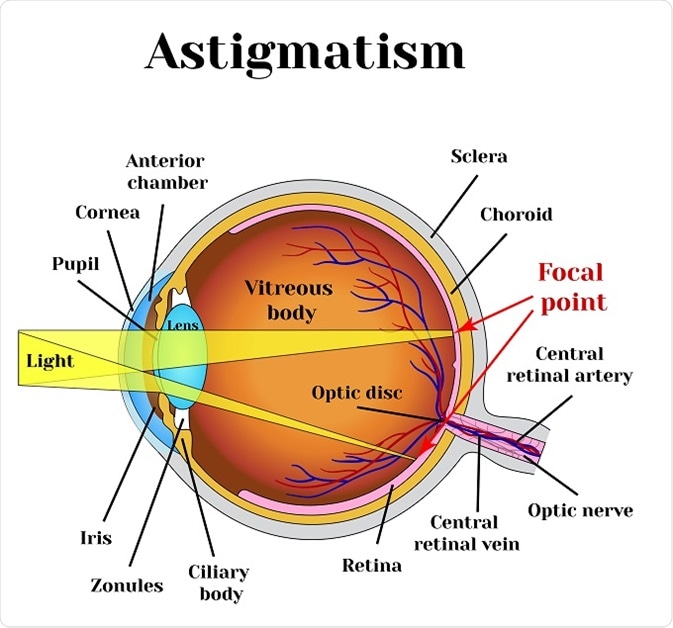Eyesight refers to the capability of an individual to view things. The eyes collect the light from an object that is processed by the brain. The retina is a light-responsive layer that acts as a screen located at the back of each eye. It has photosensitive cells that are responsible for the transfer of information collected from the light to the brain through the optic nerve. If the image constituted on the retinal layer is clear, then the person has a good eyesight.
Poor eyesight caused by mutant genes
- Genes causing myopia
Myopia is a condition where the objects at a distance occur blurry, while closer objects appear clear. This is because the light gets focused in front of the retina and not on the retina. Genome wide association studies (GWAS) and next-generation sequencing (NGS) studies have determined about 24 genes that cause several types of myopia. Among them are the following:
- Molecular cause of myopia is attained by modification in the genes (ANTXR2, KCNQ5, LAMA2, PRSS56, RASGRF, RDH5, VAX2, SHISA6, TJP2, TOX/CA8, ZIC2 68, 70).
- Mutation of genes which include CTSH, LEPREL1, SCO2, SLC39A5, ZNF644, 56 and WNT7B can cause sporadic myopia.
- Age-related macular degeneration is caused by the mutation of CFH72, ARMS2-HTRA1 genes.
- Single nucleotide polymorphism (SNP) in these genes (BLID, SCO2, 62CTNND2, 63 MIPEP, 65ZC3H11B, VIPR2 66, 67 and SNTB167, 68) results in high myopia.
- Scientists have found that the variant APLP2 gene can cause myopia in teenagers if they read for more than an hour. However, people with this variant are rare around the world.
- An irregular action of the LEPERL1 gene raises the risk of myopia. This gene secretes an enzyme that participates in the last stage of collagen formation in the eye. When the enzyme is not active, an abnormal collagen is formed which makes the eyeball bigger than normal. Thus the light gets concentrated in front of the retina.

©Mrs_Bazilio/ Shutterstock.com
Myopic genes and their functions
The genes associated with myopia involve in some specific pathways as follows:
Genes undergoing ion transport, regulation of membrane potential, and channel activity are KCQN5, CD55, CACNA1D, KCNJ2, CHRNG, and MYOID. Neural signaling is by GRIA4, GJD2, RASGRF1, 70DLG2, KCNMA1, LRRC4C, RBFOX1, TJP2. Extracellular matrix remodeling is by LAMA2, BMP2,3, and ANTXR2. Retinoic acid metabolism by RDH5, RURB, CYP26A1.SIX6, PRSS56, CHD7, ZBTB38, ZIC2, 70BMP4, DLX1 genes involves in the development of the eyes. Genes that participate in retinal ganglion cell projection are ZIC2 and ZMAT4. The SCO2 gene is responsible for the metabolism of copper, which is essential for the regulation of oxygen in the eyes.
- Genes causing hyperopia
People with hyperopia have complications in viewing objects near to them, but are able to see objects at a distance. This is because the cornea becomes flat in shape. The gene responsible for hyperopia is the phosphodiesterase 11A gene (PDE11A).
- PDE11A plays an important role in conduction of signals for the management of eye growth. Tetratricopeptide repeat domain 30A (TTC3OA) protein and the alkylglycerone phosphate synthase (AGPS) are also involved in signal conduction between neurons along with PDE11A. The variant PDE11A is responsible for causing hyperopia.
- Cataracts develop by the mutation of AGPS, which is combined with a disorder of the multisystem development.
- The MFRP gene helps to maintain the shape of the cornea and aids in the focusing mechanism. Mutation of this gene leads to farsightedness, retinitis pigmentosa, and micropthalamos.
- Genes behind astigmatism
Astigmatism is a condition in which the curvature of the cornea is a blemish and leads to blurred perception. Studies have identified three major genes responsible for the development of astigmatism.
- The PDGFRA gene binds to the receptor called platelet-derived growth factor (PDGF). PDGF is identified in the multiplying of retinal tissues, corneal epithelium, and it regulates the movement of corneal fibroblast. When the PDGFRA gene is arranged with three SNPs on chromosome 4q12, it results in the corneal bio-metrics leading to assurance of corneal astigmatism.
- The SHH (sonic hedgehog) gene plays a vital role in the development of several tissues, which also includes the eye. Studies have proclaimed that SHH gene is associated with irregular astigmatism.
- The VAX2 gene plays a major function in cornea development and increases the risk of astigmatism.

©Mrs_Bazilio/ Shutterstock.com
- Genes behind presbyopia
This condition is not a disease. Our eyes moderately fail in the capacity to view certain images due to aging. The lens cannot alter its shape to focus on objects as it becomes inflexible with age, and makes it tough to concentrate on closer things. Researchers have revealed two genes involved in presbyopia.
- Crystalline alpha A (CRYAA) comprises two genes: alpha-A and alpha-B. Mutations in these genes lead to congenital cataract and presbyopia.
- The protein concealed by a gene called RP1L1 along with retinal-specific protein plays a crucial role in altering the rod photoreceptors, thereby affecting the photosensitivity. Occult macular dystrophy is caused by the variation of this gene.